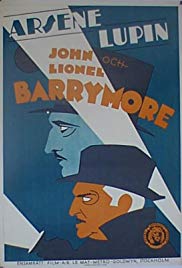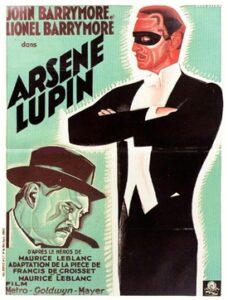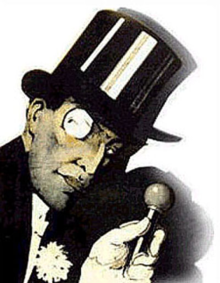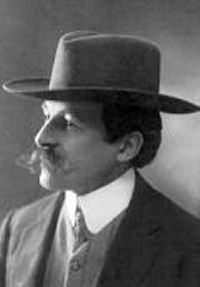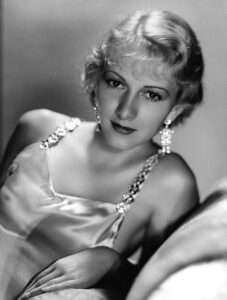Arsène Lupin **** (1932, John Barrymore, Lionel Barrymore, Karen Morley) – Classic Movie Review 8,676
MGM brings Maurice Leblanc’s famous gentleman crook to the screen for its first sound incarnation in 1932 with both Barrymore brothers in the popular pre-Code mystery film Arsène Lupin.
Director Jack Conway has the privilege of bringing Maurice Leblanc’s famous gentleman crook Arsène Lupin to the screen for its first sound incarnation in 1932 with both Barrymore brothers in the popular MGM pre-Code mystery film Arsène Lupin.
A dashing and daring posh Paris gentleman crook and jewel thief known as Arsène Lupin tries to rob silly nobleman Gourney-Martin (Tully Marshall)’s safe in a country estate, and then goes on to steal the Mona Lisa from the Louvre, in MGM’s effervescent romantic crime caper. The Barrymore brothers, John and Lionel, give entertainingly fruity but skilful performances as (respectively) the master robber Arsène Lupin aka the Duke of Charmerace, and the cranky, dogged police detective Guerchard pursuing him, in the star actors’ first screen appearance together.
[Spoiler alert] Of course, naturally, the film culminates in the recovery of the Mona Lisa and Arsène Lupin (at least temporarily) under arrest.
Arsène Lupin is crisp, classy vintage crime entertainment, a lovingly polished and cannily performed movie, based on a popular 1909 play by Maurice Leblanc and Francis de Croisset.
In a pre-Code highlight, the Duke of Charmerace (John Barrymore) finds the beautiful woman thief Sonia (Karen Morley) Guerchard has sent to trap him naked in his bed, turns off the lights and makes love. There are further attractive scenes with John Barrymore all over Morley, kissing and canoodling. Indeed, John Barrymore’s romance with Morley is one of the film’s delights, with the brittlely alluring blonde Morley giving nearly as good as she gets in her scenes with the scene-stealing, show-topping star. Their chemistry is nearly as good as that of the Barrymore brothers. Their double act is the film’s raison d’être, and they are tremendously entertaining, with John generally being suave and sophisticated and underplaying and Lionel being ripe and crusty and overplaying. Their contrasting turns work well together in a film that is essentially a battle of wits between their two characters. Acting together has lifted both men’s games. It is a delight to watch.
The MGM production is notably lavish, and most attractive to look at as a backdrop to the story. It’s a shame that the mystery story is quite so thin, with too much interest and time spent on the romance and the comedy. But it is still a very enjoyable, appealing vintage movie, actually quite charming.
The cast
The cast are John Barrymore as the Duke of Charmerace, Lionel Barrymore as Detective Guerchard, Karen Morley as Sonia, John Miljan as Prefect of Police, Tully Marshall as Gourney-Martin, Henry Armetta as Sheriff’s man, George Davis as Sheriff’s man, John Davidson as Butler, James T Mack as Laurent, Mary Jane Irving as Marie, Olaf Hytten as Party Guest (uncredited), Leo White as Jeweller (uncredited), Mischa Auer as Louvre Tour Guide, Theodore Lorch as Lupin’s Butler, Georges Renavent as Duval, Joe Sawyer as Leroux, Nicholas Soussanin as Gourney-Martin’s Butler, and Roland Varno as Jean Moucante,
Arsène Lupin is directed by Jack Conway, runs 85 minutes, is made by MGM, is released by Loew’s Inc, is written by Carey Wilson (screenplay), Lenore J Coffee and Bayard Veiller (dialogue), based on a play by Maurice Leblanc and Francis de Croisset, is shot in black and white by Oliver T Marsh, is produced by Louis B Mayer, Irving Thalberg and Samuel Goldwyn, is scored by Alfred Newman, and is designed by Cedric Gibbons.
Release date: March 5, 1932.
The film grossed $1,110,000 worldwide, making a profit of $245,000 on a budget of $433,000.
The opening title stars the Barrymores together as a pair: John and Lionel Barrymore. They appeared in four more films together: Grand Hotel (1932), Rasputin and the Empress (1932), Night Flight (1933), and (with no scenes together) Dinner at Eight (1933).
Star siblings John Barrymore, Lionel Barrymore and Ethel Barrymore appeared in only one movie together, Rasputin and the Empress (1932).
Lionel Barrymore was the favourite actor of MGM studio boss Louis B Mayer, who promptly grabbed John Barrymore, too, the moment his Warner Bros contract expired. It is his first MGM film under his new contract.
Arsène Lupin Returns followed in 1938 with Melvyn Douglas and Enter Arsène Lupin in 1944 with Charles Korvin. The Adventures of Arsène Lupin [Les Aventures d’Arsène Lupin] (France, 1957) with Robert Lamoureux as Lupin is an outstanding colour version featuring the character.
Arsène Lupin author Maurice Leblanc.
Arsène Lupin in the movies.
Arsène Lupin has provided a rich seam to mine for the movies. These are the many films of the books: The Gentleman Burglar (B&W, US, 1908) with William Ranows (Lupin), Arsène Lupin contra Sherlock Holmes (B&W, Germany, 1910) with Paul Otto (Lupin), Arsène Lupin (B&W, France, 1914) with Georges Tréville (Lupin), The Gentleman Burglar (B&W, US, 1915) with William Stowell (Lupin), Arsène Lupin (B&W, UK, 1916) with Gerald Ames (Lupin), Arsène Lupin (B&W, US, 1917) with Earle Williams (Lupin), The Teeth of the Tiger (B&W, US, 1919) with David Powell (Lupin), 813 (B&W, US, 1920) with Wedgewood Nowell (Lupin) and Wallace Beery, Les Dernières aventures d’Arsène Lupin (B&W, France/Hungary, 1921), 813 – Rupimono (B&W. Japan, 1923) with Minami Mitsuaki (Lupin), Arsène Lupin (B&W, US, 1932) with John Barrymore (Lupin), Arsene Lupin, Detective (Arsène Lupin détective, B&W, France, 1937) with Jules Berry (Lupin), Arsène Lupin Returns (B&W, US, 1938) with Melvyn Douglas (Lupin), Enter Arsène Lupin (B&W, US, 1944) with Charles Korvin (Lupin), Arsenio Lupin (B&W, Mexico, 1945) with R. Pereda (Lupin), Nanatsu-no Houseki (B&W, Japan, 1950) with Keiji Sada (Lupin), Tora no-Kiba (B&W, Japan, 1951) with Ken Uehara (Lupin), Kao-no Nai Otoko (B&W, Japan, 1955) with Eiji Okada (Lupin), The Adventures of Arsène Lupin (Les Aventures d’Arsène Lupin, col, France, 1957) with Robert Lamoureux (Lupin), Signé Arsène Lupin (B&W, France, 1959) with Robert Lamoureux (Lupin), Arsène Lupin contre Arsène Lupin [fr] (B&W, France, 1962) with Jean-Pierre Cassel and Jean-Claude Brialy (Lupins), Arsène Lupin (col, France, 2004) with Romain Duris (Lupin), and Lupin no Kiganjo (col, Japan, 2011) with Kōichi Yamadera (Lupin).
Karen Morley (born Mildred Linton; December 12, 1909 – March 8, 2003
Karen Morley’s film career came to an end in 1952) when she testified before the House Un-American Activities Committee and refused to answer questions about her alleged American Communist Party membership. She maintained her political activism for the rest of her life.
© Derek Winnert 2019 Classic Movie Review 8,676
Check out more reviews on http://derekwinnert.com

